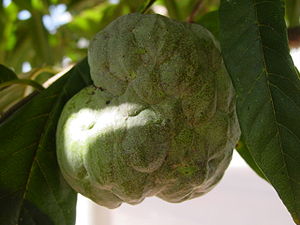Note: This is a project under development. The articles on this wiki are just being initiated and broadly incomplete. You can Help creating new pages.
Difference between revisions of "Annonaceae - Sitaphalam"
(Created page with "thumb|right|''Sitaphalam'', ''Annonaceae'' The Annonaceae are a family, the custard apple family, of flowering plants consisting of trees, shrubs...") |
Chaithrika (talk | contribs) (+Common names) |
||
| Line 21: | Line 21: | ||
*Some species of the family, such as Cananga odorata (ylang-ylang) also have aromatic oil and are used for perfumes or spices | *Some species of the family, such as Cananga odorata (ylang-ylang) also have aromatic oil and are used for perfumes or spices | ||
*The strong bark is used for carrying burdens in the Amazon Rainforest[5] and for wooden implements, such as tool handles and pegs.[26] The wood is valued as firewood. | *The strong bark is used for carrying burdens in the Amazon Rainforest[5] and for wooden implements, such as tool handles and pegs.[26] The wood is valued as firewood. | ||
| + | |||
| + | ==Common name== | ||
| + | |||
| + | * '''kannada''' - ಸೀತಾಫಲ | ||
== References == | == References == | ||
Revision as of 13:18, 9 March 2017
The Annonaceae are a family, the custard apple family, of flowering plants consisting of trees, shrubs, or rarely lianas. It is the largest family in the Magnoliales. Several genera produce edible fruit, most notably Annona, Anonidium, Asimina, Rollinia, and Uvaria. Common names custard apple, sugar apple, ata,[1]
Description
The species are mostly tropical, some are mid-latitude, deciduous or evergreen trees and shrubs, with some lianas, with aromatic bark, leaves, and flowers.
Fruits and seeds
Fruits are single berries or coalesce from several pistils (into aggregate fruit, syncarps). Seeds are one to many per pistil; have a fleshy and usually brightly colored cover, have ruminate endosperm (nutritive tissue surrounding the embryo) and are oily.
Flowers
Flower stalks are axillary to (on the opposite side of shoot from) leaf scars on old wood and sometimes from leaves on new shoots. The flowers are usually trimerous; borne singly or in compound inflorescences; bisexual and rarely unisexual.
Uses
- The bark, leaves, and roots of some species are used in folk medicines.
- The compound annonacin in the seeds and leaves of many Annonaceae including Annona muricata (soursop), is a neurotoxin and it seems to be the cause of a neurodegenerative disease.
- Some species of the family, such as Cananga odorata (ylang-ylang) also have aromatic oil and are used for perfumes or spices
- The strong bark is used for carrying burdens in the Amazon Rainforest[5] and for wooden implements, such as tool handles and pegs.[26] The wood is valued as firewood.
Common name
- kannada - ಸೀತಾಫಲ
